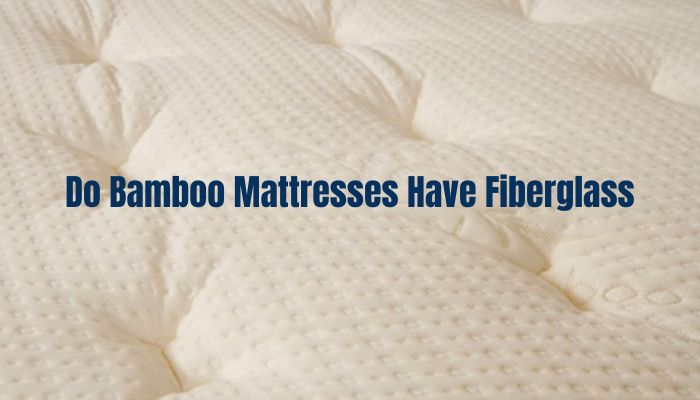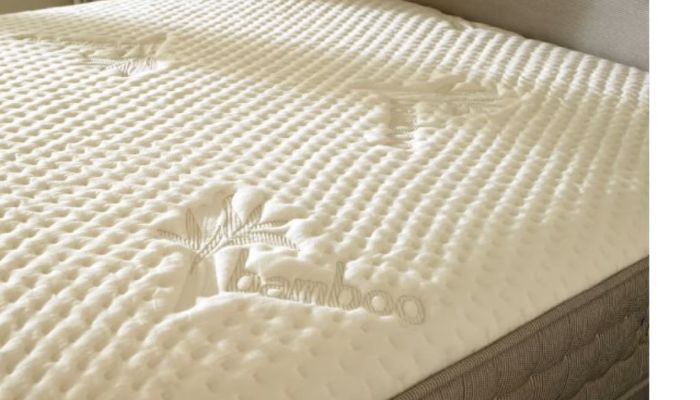Uncover the truth about bamboo mattresses and fiberglass content. Comprehensive guide on what you need to know before buying a bamboo mattress.
Welcome to the world of mattresses, a place where comfort meets science. As the trend for healthier living rises, more and more people are leaning towards organic and natural products. One such product that has gained immense popularity is the bamboo mattress. However, some concerns and myths surround these mattresses, specifically regarding using Fiberglass. In this article, we will demystify the truth about Fiberglass in bamboo mattresses, its pros and cons, and how to determine if your bed contains it.
The Truth About Fiberglass in Bamboo Mattresses
Many discussions have been going on about using Fiberglass in mattresses, especially bamboo mattresses. Fiberglass is a component found in various household items, including insulation, windows, and even some mattresses. But what exactly is Fiberglass, and why is it used in beds?
What is Fiberglass, and Why is it Used in Mattresses?
Definition of Fiberglass
Fiberglass is a type of fiber-reinforced plastic where the reinforcement fiber is specifically glass fiber. It is lightweight, strong, and less brittle. The glass fibers may be arranged randomly, flattened into a sheet, or woven into a fabric.
Reasons for Using Fiberglass in Mattresses
Fiberglass is used in mattresses for a few reasons:
- Flame Retardant: Fiberglass is a natural flame retardant. This means it can slow the spread of fire, a crucial safety feature required in many countries.
- Affordability: It is an affordable material, which helps keep the mattress’s cost down.
- Support: It provides support and structure to the mattress, helping it to keep its shape over time.
Different Types of Bamboo Mattresses
100% Bamboo Mattresses
These are made entirely from bamboo fibers. They are known for being incredibly soft, breathable, and eco-friendly. However, they are less common and can be pretty expensive.
Bamboo Hybrid Mattresses
These mattresses combine bamboo fibers with other materials like springs or memory foam. They offer a balance between comfort, support, and affordability.
Bamboo Memory Foam Mattresses
These mattresses combine bamboo fibers with memory foam. They offer the comfort of memory foam with bamboo’s breathability and moisture-wicking properties.
Read more about Does Lucid Mattress Have Fiberglass?
The Pros and Cons of Fiberglass in Mattresses
Pros of Fiberglass
- Fire Resistance: As mentioned earlier, Fiberglass is a natural flame retardant, a crucial safety feature.
- Cost-Effective: It is an affordable material that helps keep the mattress cost down.
- Support: Provides structure and support to the mattress, helping it maintain its shape over time.
Cons of Fiberglass
- Irritation: Fiberglass particles can cause irritation to the skin, eyes, and respiratory system if they come into contact.
- Difficult to Remove: If fiberglass particles are released, they can be difficult to remove from the environment.
- Not Biodegradable: Fiberglass is not a biodegradable material, which means it is not environmentally friendly.
How to Determine if Your Bamboo Mattress Contains Fiberglass
Unfortunately, it is not always easy to determine if a bamboo mattress contains Fiberglass, as manufacturers are only sometimes required to list all the materials used. However, there are a few ways to find out:
- Check the Label: Some manufacturers will list Fiberglass on the label if it is used.
- Contact the Manufacturer: You can contact the manufacturer directly and ask if they use Fiberglass in their mattresses.
- Check Online Reviews: Sometimes, other consumers will mention if they discovered Fiberglass in their bed.

Alternatives to Fiberglass in Bamboo Mattresses
Why Bamboo Mattresses are Popular
Bamboo mattresses are known for their comfort, support, and eco-friendliness. Bamboo is a sustainable material that proliferates and doesn’t require pesticides or fertilizers. This makes bamboo mattresses a popular choice among eco-conscious consumers.
Common Materials Used in Bamboo Mattresses
Most bamboo mattresses consist of a bamboo-derived viscose rayon cover, a layer of memory foam, and a support core made of high-density foam. However, some manufacturers also include a layer of Fiberglass to make the mattress fire-resistant.
Fiberglass in Mattresses
Fiberglass is used in mattresses as a fire barrier because it is cheap and effective. However, it can pose health risks if not adequately contained. Fiberglass particles can become airborne and be inhaled or come into contact with the skin, causing irritation and other health issues.
Alternative Materials to Fiberglass
Several alternatives to Fiberglass can be used as a fire barrier in mattresses. Some of these include:
- Wool: Wool is a natural fire-resistant material that can be used as an alternative to Fiberglass. It is also hypoallergenic and moisture-wicking.
- Kevlar: Kevlar is a synthetic material known for its strength and fire-resistant properties. It is commonly used in bulletproof vests and other protective gear.
- Graphite: Graphite is a naturally fire-resistant mineral. It is often used with other materials to enhance its fire-resistant properties.
- Rayon: Rayon is an artificial fiber created from wood pulp. It can be treated with fire-resistant chemicals to make it suitable as a fire barrier in mattresses.
The Health Risks Associated with Fiberglass Exposure
Understanding Fiberglass
Fiberglass is a type of fiber-reinforced plastic where the reinforcement fiber is specifically glass fiber. It is lightweight, strong, and less brittle, making it a popular choice for various applications, including insulation, automotive parts, and mattresses.
Health Risks of Fiberglass
Exposure to Fiberglass can lead to several health issues, including:
- Skin Irritation: Fiberglass particles can cause itchiness and irritation when they come into contact with the skin.
- Respiratory Issues: Inhaling fiberglass particles can cause respiratory problems, such as coughing, wheezing, and shortness of breath.
- Eye Irritation: Fiberglass particles can cause redness and irritation if they come into contact with the eyes.
Preventing Exposure to Fiberglass
It is essential to take precautions to prevent exposure to Fiberglass. Some tips include:
- Use a Mattress Protector: A mattress protector can help contain the fiberglass particles and prevent them from becoming airborne.
- Proper Maintenance: Regularly inspect your mattress for any signs of wear and tear. If the cover is damaged, it is best to replace it immediately to prevent fiberglass particles from escaping.
- Proper Disposal: If you need to dispose of a mattress containing Fiberglass, it is essential to do so correctly to prevent the spread of fiberglass particles.
How to Properly Dispose of a Mattress with Fiberglass
Why Proper Disposal is Important
Properly disposing of a fiberglass mattress is crucial to prevent the spread of fiberglass particles. These particles can become airborne and pose health risks to those exposed.
Steps to Dispose of a Mattress with Fiberglass
- Seal the Mattress: Before disposing of the mattress, it is essential to seal it in a plastic mattress bag to contain the fiberglass particles.
- Check Local Disposal Regulations: Some areas have specific regulations for disposing of Fiberglass mattresses. It is essential to check with your local waste management facility to understand the proper disposal procedure.
- Hire a Professional: If you are unsure how to properly dispose of a fiberglass mattress, hiring a professional disposal service may be best.

FAQs: Everything You Need to Know About Bamboo Mattresses and Fiberglass
Frequently Asked Questions
Can I remove the Fiberglass from my mattress?
Removing the Fiberglass from your mattress is not recommended, as it can cause the particles to become airborne and pose health risks. Instead, it is best to replace the bed with one that does not contain Fiberglass.
Are there any bamboo mattresses that do not contain Fiberglass?
Yes, there are bamboo mattresses available that do not have Fiberglass. It is essential to check the product specifications and inquire with the manufacturer to ensure the bed does not contain Fiberglass.
What are the symptoms of fiberglass exposure?
Symptoms of fiberglass exposure can include skin irritation, respiratory issues, and eye irritation.
How can I prevent exposure to Fiberglass?
To avoid the disclosure of Fiberglass, it is essential to use a mattress protector, regularly inspect your mattress for any signs of wear and tear, and properly dispose of a Fiberglass mattress.
What are the alternatives to Fiberglass in mattresses?
Choices for Fiberglass in mattresses include wool, Kevlar, graphite, and rayon treated with fire-resistant chemicals.
Making an Informed Decision: Choosing the Right Bamboo Mattress for You
When choosing a bamboo mattress, considering the materials used, especially the fire barrier, is essential. While Fiberglass is a common and effective fire barrier, its potential health risks make it a less desirable option for many. Alternatives like wool, Kevlar, graphite, and treated rayon can provide the same fire-resistant properties without the associated health risks.
Conclusion
Bamboo mattresses are famous for their comfort, support, and eco-friendliness. However, using Fiberglass as a fire barrier in some mattresses has raised concerns about potential health risks. It is essential to be informed about the materials used in a bed, especially the fire barrier, and consider the available alternatives. By taking the necessary precautions, you can enjoy the benefits of a bamboo mattress without the risks associated with fiberglass exposure.
